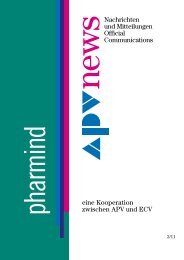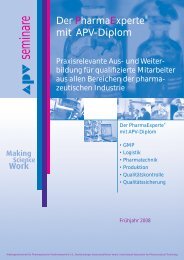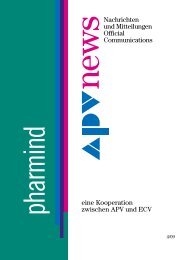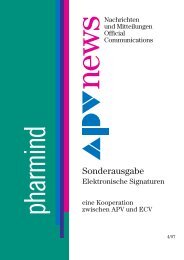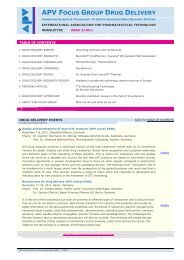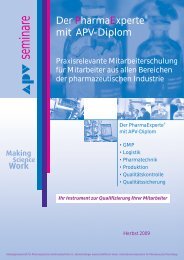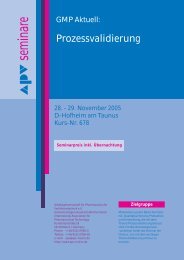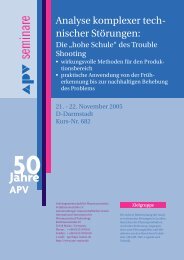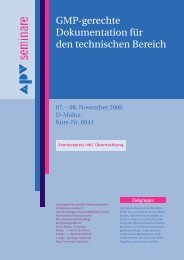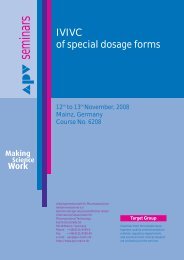APV FOCUS GROUP DRUG DELIVERY
APV FOCUS GROUP DRUG DELIVERY
APV FOCUS GROUP DRUG DELIVERY
Create successful ePaper yourself
Turn your PDF publications into a flip-book with our unique Google optimized e-Paper software.
Parma<br />
Institution Italy, Parma: Università degli studi die Parma<br />
Group Dipartimento Farmaceutico<br />
Key contact Prof. ssa Patrizia Santi<br />
Website http://www.unipr.it/arpa/dipfarm/<br />
E-Mail patrizia.santi@unipr.it<br />
Research areas • Mechanisms involved in iontophoretic drug transport (passive diffusion, electrotransport<br />
and electroosmosis),<br />
• Iontophoretic delivery of peptides and proteins,<br />
• Reverse iontophoresis for diagnostic purposes and<br />
• Realization of innovative transdermal drug delivery systems.<br />
Disclaimer: Although every effort has been made to check the accuracy of the contents of the tables, including contacting<br />
the groups involved, there may be some inaccuracies and/or omissions.<br />
FEATURED ARTICLE BACK TO TABLE OF CONTENTS<br />
THE ÉLAN OF <strong>DELIVERY</strong> TECHNOLOGY DEVELOPMENT<br />
By Louise Rosenmayr-Templeton, Ph.D., Tower Pharma Consulting, Auhofstrasse 197/10, A-1130 Vienna<br />
1. Introduction<br />
On 9 May 2011 it was announced that Alkermes Inc. (Waltham, MA, USA) and the Elan Corporation plc (Dublin, Ireland)<br />
had signed an agreement under which Alkermes would merge with Elan Drug Technologies (EDT), the drug delivery<br />
division of the Elan Corporation [1]. The cash and stock transaction is valued at US $960 with Elan receiving US $500<br />
million cash plus an around 25 % stake in the new company to be named Alkermes plc and headquartered in Ireland.<br />
The deal, which at the time of writing this article, was still subject to the approval of Alkermes shareholders, regulatory<br />
go-ahead and customary closing conditions, creates a company with over 25 commercialised products and a pipeline of<br />
proprietary and partnered products. The focus will be on products for the treatment of diseases of the Central Nervous<br />
System which fits with the portfolios of both parties to the merger.<br />
Although the Elan Corporation’s 25 % stake in Alkermes plc means that it has not completely divorced itself from the<br />
world of drug delivery, it is to an extent the end of an era. That era began in Ireland in 1969 when the American entrepreneur,<br />
Donald Panoz, founded the company, which was then solely focused on improving the oral delivery of established<br />
drugs through the development of novel formulation technologies<br />
This short review article looks back at the company’s contribution to therapeutic delivery in terms of technologies<br />
currently used in commercialized or late stage clinical products. It includes some technologies that are no longer part of<br />
the Elan portfolio but were spun-out or sold to other companies. In the interest of brevity I have deliberately excluded<br />
technologies which were owned by the company for a short time. These include those developed by the former Quadrant<br />
Healthcare (through the acquisition of Innovata plc now part of the Ventura Group [2, 3]) and The Liposome<br />
Company whose Abelcet® product is now sold by Sigma Tau Pharmaceuticals Inc. [4]. The article also looks briefly at<br />
some of the start-up companies that came into being following Elan’s financial difficulties in 2002/2003.<br />
2. Technologies Currently within the Elan Drug Technologies Portfolio<br />
2.1 NanoCrystal ® Technology<br />
NanoCrystal ® technology, is Elan’s particle size reduction technology to increase the solubility of poorly-soluble drugs<br />
[5-7]. This technology did not originate within Elan itself, but was initially developed by NanoSystems LLC, a subsidiary<br />
of Eastman Kodak [8]. It employed Eastman’s expertise in milling pigments to develop a wet milling and particle stabilization<br />
technology to reduce the size of drug particles to less than 2000 nm and maintain their physical stability over<br />
time. Stabilisation against agglomeration is achieved by absorbing selected GRAS (Generally Regarded As Safe) stabilizers<br />
to the surface of the particles. The resulting solution can be further processed and incorporated into a variety of<br />
dosage forms.<br />
It was in the late 1990s that it became apparent that this technology showed great promise in improving the bioavailability<br />
of drugs whose solubility was dissolution-rate limited. In September 1998 Elan bought NanoSystems from Eastman<br />
Kodak for US $150 million [8]. The NanoCrystal technology is Elan’s most successful delivery technology and is the<br />
basis of 5 marketed products which generated US $1.9 billion plus in annual in-market sales in 2010. These include<br />
Rapamune ® Tablets (Wyeth, now Pfizer), Megace ® ES Suspension (Strativa Pharmaceuticals), Emend ® Capsules (Merck)<br />
and Tricor ® 145 Tablets (Abbott Laboratories). Use of the technology has in some cases not only improved bioavailability,<br />
but also allowed dose reduction (Tricor ® 145) and/or removed or reduced the effect of food on drug absorption<br />
<strong>APV</strong> Drug Delivery Focus Group Newsletter – 2/2011 Page 8 of 15



